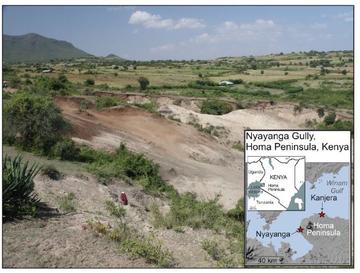
Nyayanga site in July 2014 prior to excavation. Photo credit: T.W. Plummer
Along the shores of Africa’s Lake Victoria in Kenya roughly 2.9 million years ago, early human ancestors used some of the oldest stone tools ever found to butcher hippos and pound plant material, according to new research led by an international team of scientists, including Dr Peter Ditchfield of the Research Laboratory of Archaeology and the History of Art (RLAHA).
The study, published today, in the journal Science, presents what are likely to be the oldest examples of a hugely important stone-age innovation known to scientists as the Oldowan toolkit, as well as the oldest evidence of hominins consuming very large animals.
The site featured at least three individual hippos. Two of these incomplete skeletons included bones that showed signs of butchery. The team found a deep cut mark on one hippo’s rib fragment and a series of four short, parallel cuts on the shin bone of another. They also found antelope bones that showed evidence of hominins slicing away flesh with stone flakes or of having been crushed by hammerstones to extract marrow.The analysis of wear patterns on 30 of the stone tools found at the site showed that they had been used to cut, scrape and pound both animals and plants. Because fire would not be harnessed by hominins for another 2 million years or so, these stone toolmakers would have eaten everything raw, perhaps pounding the meat into something like a hippo tartare to make it easier to chew.
Using a combination of dating techniques, including the rate of decay of radioactive elements, reversals of Earth’s magnetic field and the presence of certain fossil animals whose timing in the fossil record is well established, the research team was able to date the items recovered from Nyayanga to between 2.58 and 3 million years old.
Excavations at the site, named Nyayanga and located on the Homa Peninsula in western Kenya, also produced a pair of massive molars belonging to the human species’ close evolutionary relative Paranthropus. The teeth are the oldest fossilized Paranthropus remains yet found, and their presence at a site loaded with stone tools raises intriguing questions about which human ancestor made those tools, said Rick Potts, senior author of the study and the National Museum of Natural History’s Peter Buck Chair of Human Origins. The discovery of teeth from the muscular-jawed Paranthropus alongside these stone tools begs the question of whether it might have been that lineage rather than the Homo genus that was the architect of the earliest Oldowan stone tools, or perhaps even that multiple lineages were making these tools at roughly the same time.
Read more here.